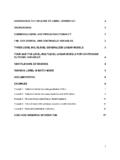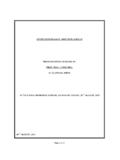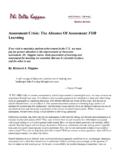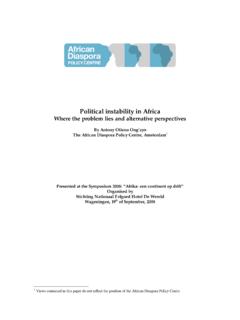Transcription of On Chi-Squares for the Independence Model and Fit Measures ...
1 On Chi-Squares for the Independence Model and Fit Measures in LISREL. Karl G J oreskog 15 January 2004. LISREL computes many t Measures for the estimated Model . Most of these, , RMSEA, ECVI, and AIC, depend on chi- square for the Model . Some others, , NFI, NNFI, CFI, IFI, and RFI, depend on chi- square for the Independence Model as well. Things become complicated because there are up to four di erent Chi-Squares (C1, C2, C3, and C4, explained in the next section). computed for the Model and, in principle, there are also four di erent Chi-Squares (C1i, C2i, C3i, and C4i) for the Independence Model . Which chi- square and combination of Chi-Squares should be used to compute the t Measures ?
2 Some of the Chi-Squares are valid under non-normality and some are valid only under normality (to be precise this should be multivariate normality). Things get even more complicated because the Chi-Squares depend also on the method of estimation used to t the Model to the data. As LISREL has at least ve estimation methods (ULS, GLS, ML, WLS, and DWLS), there is a variety of Chi-Squares that can be used, and hence, many t Measures that can be computed from them. Previous versions of LISREL sometimes use C1, sometimes C2, and sometimes C3. For example, with ML, LISREL uses C3 to compute RMSEA and C2 and C2i to compute most other t Measures . The worst problem is with ULS and DWLS where LISREL sometimes uses C1 which does not have an asymptotic chi- square distribution.
3 In LISREL we have corrected these anomalies so that C2 and C2i are used under normality, , if no asymptotic covariance matrix is provided, and C3 and C3i are used under non-normality, , if an asymptotic covariance matrix is provided. Furthermore, LISREL provides an addi- tional new table of t Measures where users can see (as in a spread sheet) how the t Measures depend on (C1,C1i), (C2,C2i), (C3,C3i), and (C4,C4i). Previously this was not possible because C3i and C4i were not available within the program1 . The choice of C2 and C2i instead of C1 and C1i is not based on the belief that C2 and C2i are better Chi-Squares than C1 and C1i. Rather it is because C2 and C2i have asymptotic Chi-Squares for all methods of estimation, which is not the case with C1 and C1i.
4 On the other hand, the choice of C3 and C3i instead of C4 and C4i is based on the belief that C3 and C3i are better Chi-Squares than C4 and C4i unless the sample size is huge, see , Hu, Bentler, & Kano (1992). In this note I explain what the Independence Model is and I outline how the four Chi-Squares C1i, C2i, C3i, and C4i for the Independence Model can be computed for each method of estimation. In this description I use some material published in Chapter 4 and Appendix A of J oreskog et al. (2003). 1. One could of course obtain all four Chi-Squares for the Independence Model by running the Independence Model as the Model to be estimated. However, new in LISREL is that these Chi-Squares are computed internally in LISREL for any single group Model , and they can therefore be used to compute all fit Measures .
5 1. The objective of this note is not to discuss the advantages and disadvantages of various t Measures . The formulas for the t Measures and references to the original papers where they were rst proposed are given in Chapter 4 of J oreskog & S orbom (2002). Readers are referred to these original sources and other papers for a discussion of the pros and cons of the various t Measures . A comprehensive simulation study of their performances in di erent situations has been performed by Hammervold (1998). 1 The four di erent Chi-Squares The four di erent Chi-Squares are denoted C1, C2, C3, C4. Which ones are obtained in di erent situations is seen in the following table, where means obtained and means not obtained (.)
6 Means that C2 will be obtained only if the asymptotic variances are provided). Asymptotic Covariance Matrix not Provided ULS GLS ML WLS DWLS. C1 . C2 . C3 . C4 . Asymptotic Covariance Matrix Provided ULS GLS ML WLS DWLS. C1 . C2 . C3 . C4 . Let N be the sample size. C1 is N 1 times the minimum value of the t function. C2 is N 1 times the minimum value of the WLS t function using a weight matrix estimated under multivariate normality. C3 is the Satorra-Bentler scaled chi- square statistic (Satorra & Bentler, 1988, equation ). C4 is N 1 times the minimum value of the WLS t function using a weight matrix estimated under multivariate non-normality (as provided by PRELIS).
7 C4 is computed from equation ( ) in Browne (1984). A uni ed presentation of these Chi-Squares is given in Appendix A in J oreskog et al. (2003). Under multivariate normality of the observed variables, C1 and C2, whenever provided, are asymptotically equivalent and have an asymptotic chi- square distribution if the Model holds ex- actly and an asymptotic non-central chi- square distribution if the Model holds approximately. The same holds for C4 under the more general assumption that the observed variables have a 2. multivariate distribution with nite moments up to order four. C3 is a correction to C2 which makes C3 have the correct asymptotic mean even under non-normality.
8 For more information, see Chapter 4 and Appendix A of J oreskog et al. (2003). In the output for LISREL, the four Chi-Squares are recognized by the following text. C1 Minimum Fit Function Chi- square C2 Normal Theory Weighted Least Squares Chi- square C3 Satorra-Bentler Scaled Chi- square C4 Chi- square Corrected for Non-Normality 2 Chi-Squares for Independence Model The formulas for the four Chi-Squares are quite complicated for a general Model . They are given in equations ( ) - ( ) in Appendix A of J oreskog et al. (2003). However, for the Independence Model , they can be considerably simpli ed. In this section I outline how they can be computed. The Independence Model is the Model which speci es that the covariance matrix of the observed variables is diagonal, and hence that all observed variables are uncorrelated.
9 It is called Independence Model because if the observed variables are multivariate normal they would be independent. However, this Model can also be considered under non-normality. Why would anyone be interested in the Independence Model ? There are only two reasons: Before a genuine LISREL Model is estimated it is recommended that the Independence Model is tested. If the Independence Model is not rejected by the data, one has no business in structural equation modeling because all the variables may be uncorrelated. The chi- square for the Independence Model is used as a baseline chi- square for computing some t Measures , notably NFI, NNFI, CFI, IFI, and RFI.
10 It is for the second reason I am writing this note. If is diagonal, it seems natural to estimate its diagonal elements by the diagonal elements of S, the covariance matrix of the observed variables estimated from the sample. Indeed, it can be shown that these estimates are ML, ULS, and DWLS estimates, , these methods of tting the Independence Model give the same estimate, namely = diag(S). However, = diag(S) is not a GLS estimate, nor a WLS estimate. Nevertheless, GLS and WLS estimates can be obtained explicitly by exploiting the fact that the Independence Model is a speci c special case of a linear covariance structure. The GLS and WLS estimates are functions of all the elements of S.











